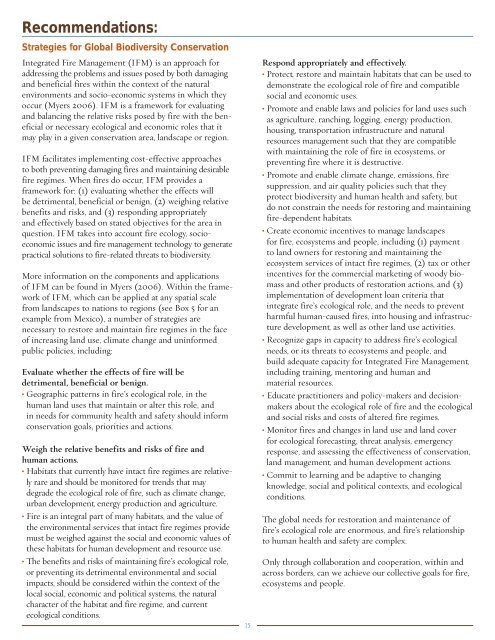Threats and Strategies for Global Biodiversity Conservation
Threats and Strategies for Global Biodiversity Conservation
Threats and Strategies for Global Biodiversity Conservation
Create successful ePaper yourself
Turn your PDF publications into a flip-book with our unique Google optimized e-Paper software.
Recommendations:<strong>Strategies</strong> <strong>for</strong> <strong>Global</strong> <strong>Biodiversity</strong> <strong>Conservation</strong>Integrated Fire Management (IFM) is an approach <strong>for</strong>addressing the problems <strong>and</strong> issues posed by both damaging<strong>and</strong> beneficial fires within the context of the naturalenvironments <strong>and</strong> socio-economic systems in which theyoccur (Myers 2006). IFM is a framework <strong>for</strong> evaluating<strong>and</strong> balancing the relative risks posed by fire with the beneficialor necessary ecological <strong>and</strong> economic roles that itmay play in a given conservation area, l<strong>and</strong>scape or region.IFM facilitates implementing cost-effective approachesto both preventing damaging fires <strong>and</strong> maintaining desirablefire regimes. When fires do occur, IFM provides aframework <strong>for</strong>: (1) evaluating whether the effects willbe detrimental, beneficial or benign, (2) weighing relativebenefits <strong>and</strong> risks, <strong>and</strong> (3) responding appropriately<strong>and</strong> effectively based on stated objectives <strong>for</strong> the area inquestion. IFM takes into account fire ecology, socioeconomicissues <strong>and</strong> fire management technology to generatepractical solutions to fire-related threats to biodiversity.More in<strong>for</strong>mation on the components <strong>and</strong> applicationsof IFM can be found in Myers (2006). Within the frameworkof IFM, which can be applied at any spatial scalefrom l<strong>and</strong>scapes to nations to regions (see Box 5 <strong>for</strong> anexample from Mexico), a number of strategies arenecessary to restore <strong>and</strong> maintain fire regimes in the faceof increasing l<strong>and</strong> use, climate change <strong>and</strong> unin<strong>for</strong>medpublic policies, including:Evaluate whether the effects of fire will bedetrimental, beneficial or benign.• Geographic patterns in fire’s ecological role, in thehuman l<strong>and</strong> uses that maintain or alter this role, <strong>and</strong>in needs <strong>for</strong> community health <strong>and</strong> safety should in<strong>for</strong>mconservation goals, priorities <strong>and</strong> actions.Weigh the relative benefits <strong>and</strong> risks of fire <strong>and</strong>human actions.• Habitats that currently have intact fire regimes are relativelyrare <strong>and</strong> should be monitored <strong>for</strong> trends that maydegrade the ecological role of fire, such as climate change,urban development, energy production <strong>and</strong> agriculture.• Fire is an integral part of many habitats, <strong>and</strong> the value ofthe environmental services that intact fire regimes providemust be weighed against the social <strong>and</strong> economic values ofthese habitats <strong>for</strong> human development <strong>and</strong> resource use.• The benefits <strong>and</strong> risks of maintaining fire’s ecological role,or preventing its detrimental environmental <strong>and</strong> socialimpacts, should be considered within the context of thelocal social, economic <strong>and</strong> political systems, the naturalcharacter of the habitat <strong>and</strong> fire regime, <strong>and</strong> currentecological conditions.15Respond appropriately <strong>and</strong> effectively.• Protect, restore <strong>and</strong> maintain habitats that can be used todemonstrate the ecological role of fire <strong>and</strong> compatiblesocial <strong>and</strong> economic uses.• Promote <strong>and</strong> enable laws <strong>and</strong> policies <strong>for</strong> l<strong>and</strong> uses suchas agriculture, ranching, logging, energy production,housing, transportation infrastructure <strong>and</strong> naturalresources management such that they are compatiblewith maintaining the role of fire in ecosystems, orpreventing fire where it is destructive.• Promote <strong>and</strong> enable climate change, emissions, firesuppression, <strong>and</strong> air quality policies such that theyprotect biodiversity <strong>and</strong> human health <strong>and</strong> safety, butdo not constrain the needs <strong>for</strong> restoring <strong>and</strong> maintainingfire-dependent habitats.• Create economic incentives to manage l<strong>and</strong>scapes<strong>for</strong> fire, ecosystems <strong>and</strong> people, including (1) paymentto l<strong>and</strong> owners <strong>for</strong> restoring <strong>and</strong> maintaining theecosystem services of intact fire regimes, (2) tax or otherincentives <strong>for</strong> the commercial marketing of woody biomass<strong>and</strong> other products of restoration actions, <strong>and</strong> (3)implementation of development loan criteria thatintegrate fire’s ecological role, <strong>and</strong> the needs to preventharmful human-caused fires, into housing <strong>and</strong> infrastructuredevelopment, as well as other l<strong>and</strong> use activities.• Recognize gaps in capacity to address fire’s ecologicalneeds, or its threats to ecosystems <strong>and</strong> people, <strong>and</strong>build adequate capacity <strong>for</strong> Integrated Fire Management,including training, mentoring <strong>and</strong> human <strong>and</strong>material resources.• Educate practitioners <strong>and</strong> policy-makers <strong>and</strong> decisionmakersabout the ecological role of fire <strong>and</strong> the ecological<strong>and</strong> social risks <strong>and</strong> costs of altered fire regimes.• Monitor fires <strong>and</strong> changes in l<strong>and</strong> use <strong>and</strong> l<strong>and</strong> cover<strong>for</strong> ecological <strong>for</strong>ecasting, threat analysis, emergencyresponse, <strong>and</strong> assessing the effectiveness of conservation,l<strong>and</strong> management, <strong>and</strong> human development actions.• Commit to learning <strong>and</strong> be adaptive to changingknowledge, social <strong>and</strong> political contexts, <strong>and</strong> ecologicalconditions.The global needs <strong>for</strong> restoration <strong>and</strong> maintenance offire’s ecological role are enormous, <strong>and</strong> fire’s relationshipto human health <strong>and</strong> safety are complex.Only through collaboration <strong>and</strong> cooperation, within <strong>and</strong>across borders, can we achieve our collective goals <strong>for</strong> fire,ecosystems <strong>and</strong> people.
















